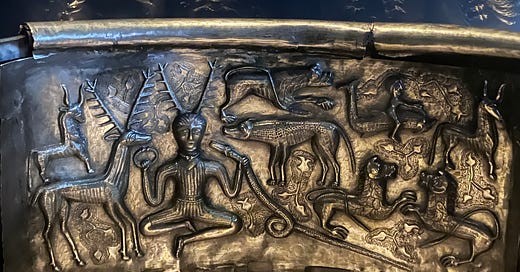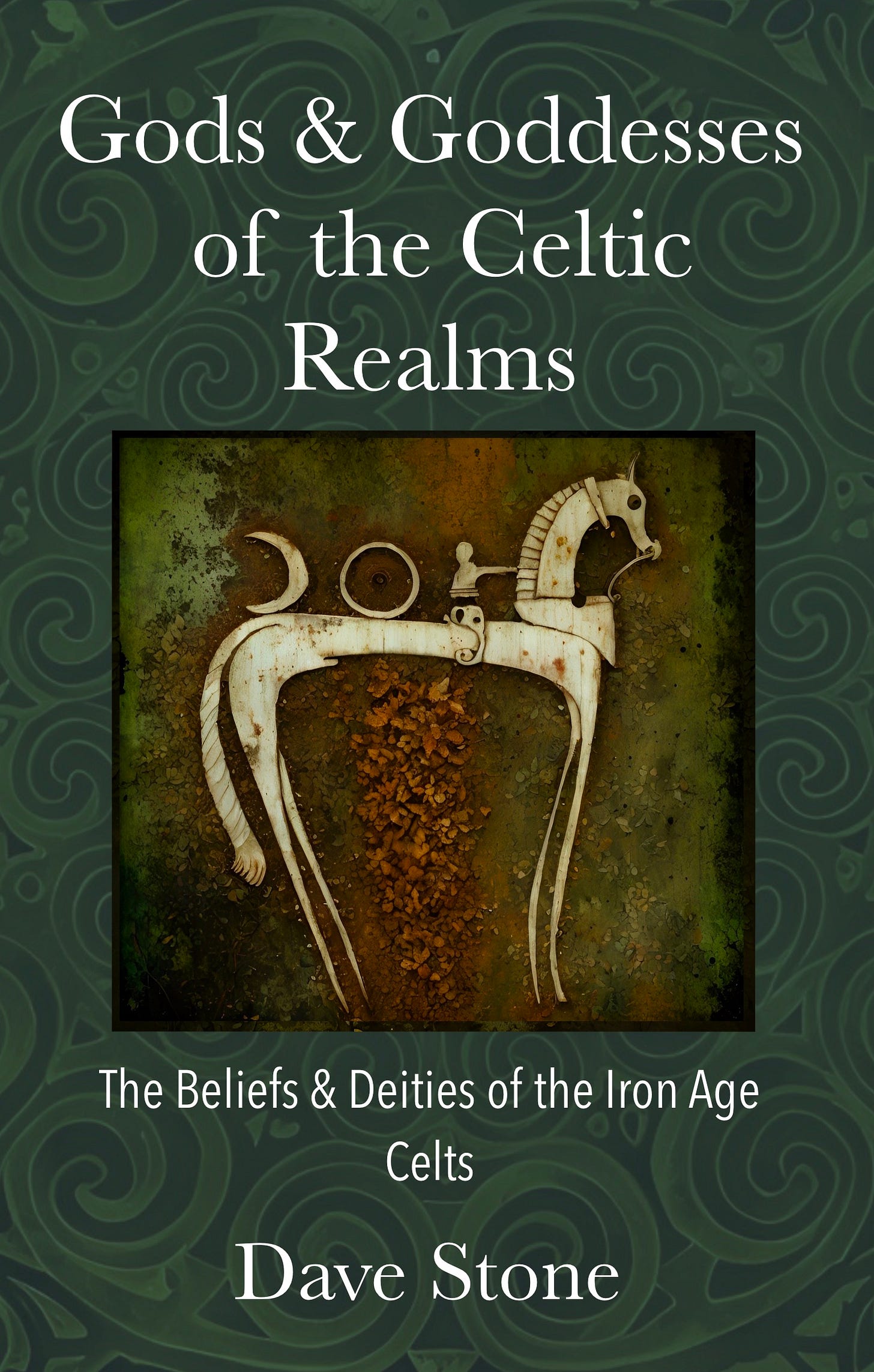The Gundestrup cauldron was placed beside a Danish bog as an offering to the gods. It is of Thracian craftsmanship and consists of thirteen panels of silver that gird the bowl*, and is dated to the 2nd century BC. Each panel depicts a scene that likely concern a ‘pantheon’ of deities. In one of these panels is the figure of a horned being, reposed in seated position, while various animals and foliage surround him. Without a doubt this is an image of the Horned God**. The cauldron is now displayed in the National Museum of Denmark, which also houses a huge ethnographic exhibition. In a room dedicated to Siberian tribespeople, I chanced across a wooden idol of an antlered human figure. A short film by an anthropologist who lived with the tribe, explains that this wooden figure was used in shamanic hunting magic.
Such horned figures are found in imagery associated with the Saami of the Artic Circle. One engraving shows a shaman with wolf-like feet, holding a drum and wearing an antler headdress. It is not dissimilar to those found at Star Carr in England, even though these were dated to Mesolithic, thousands of years before the Saami shaman image. An even more ancient image is that of the Trois Frères ’shaman,’ who was painted onto a cave wall in the Palaeolithic period. These figures are obviously divided by geography and time, and yet they all speak of ritual and hunting in animist societies. Though the rituals might have been different, it’s believed that shamanism was practiced in the remote past. However, I use the term with caution, quite aware that its popularity means ‘shaman’ is bandied about where it shouldn’t be. I use it here as a loose, umbrella term, to reflect the use of ‘animist spirit magic’, using ‘ecstatic techniques’.

In the early 20th Century, as anthropologists sought to document and understand a rapidly disappearing world, they came across antlered headdresses that were used in connection with such practices. A magnificent description of a Buryat ‘shamaness’ mentions an iron cap, mounted with two antlers. Nenet Shamans wore a crown that was divided into the four cardinal points, topped with antlers. This displayed their status as shaman and the horns directly related to their ability to travel the worlds and communicate with their denizens. The horns could also functioned as weapons to ward off, and combat, enemy shamans. It was a symbol of the wearer’s strength and virility, and with it they could summon spirit stags to aid them. The Manchu-Tunguz shamans believed that their life-soul and spirit was deer-shaped. By wearing the antlered headdress they formed a bond with their ancestor animal. Sometimes these antlers were rendered in iron, but their symbolism and intent were the same. Amongst a number of cultures a belief in the Stag of the Sky was known to exist, it enabled the shaman to fly into the sky and is of very ancient origins.
Could it be that in the figure of the Gundestrup Horned God we have a recognition of shamanic magic associated with the hunt and virility? In the Gundestrup panel the god appears alongside a mix of animals: bull, stag, goat, wolves and dogs are all present. He sits in his characteristic cross-legged pose, a position reflected in other images from across Europe, in which the Horned God is mostly seated and crosslegged. He usually bears rings, coins, torcs and is often in the presence of snakes. This serpent reference points to a link with animist spirts, the genus loci, which was viewed across ancient Europe as being serpent in form (the altar from Vendœuvres is a perfect example). The serpent also possessed Underworld associations and was the creature that could pass between worlds. The same could be said of the riches that the Horned God brandishes – metals and ores are found deep in the earth. The inclusion of the god Hermes/Mercury on a shrine from Reims, in which the Horned God is flanked by Hermes and Apollo, also hints at this Otherworldly association. Hermes is the god who acts as a messenger between the worlds. In the light of shamanic abilities this makes sense: under certain conditions, trance, hallucinogenics, etc, the shaman voyages to the realm of spirits.
Referring back to the Gundestrup cauldron, we see that the antlered lord is accompanied by two hounds or wolves. It’s tempting to associate these with the famed Cwn Annwn, the white hounds with blood red ears that hunt alongside their master, Gwyn ap Nudd. This lord of the Underworld is mentioned in much Welsh lore, and finds etymological links with the Irish hero, Fionn mac Cumhail.
In the Old Welsh story The Lady of the Fountain, the heroes come across a huge black-skinned man with one leg and a single eye. This proud giant sits upon a mound in a forest clearing, and is surrounded by all manner of beasts, including stags, serpents, lions and vipers. The beasts all obey his commands. Here we encounter a master of beasts, whose domain marks a liminal Otherworldly zone. The reference to his lone eye and single leg should remind us of the corrguinecht. This magical posture is mentioned in Irish texts; while standing with one leg raised, one eye shut and one hand raised, a magical verse known as glám dichenn was recited aloud. The stance was meant to imitate the crane/heron and may reflect a hunter becoming a crane to stalk prey in marshland. The inclusion of the single-eyed giant in this medieval tale hints at his earlier origins. Most often the giants of old are gods, stripped of their divinity by the dictates of Christianity. I suspect this figure and the Horned God are the same Master of Beasts. His darkened skin could signify that of the dead, blackened with stagnant blood, or the night sky, with his single eye representing the moon. It was reported by Julius Caesar himself that the Celts considered themselves tribes of the night, born of darkness and they reckoned their time not by days but nights***.
This image of the Master of Beasts is a very ancient archetype, found in most cultures across the world. It reveals how humans once perceived themselves in the world was very different from that of today. Distinctions between races and forms were much more fluid. The ’soul’ or ‘spirit’ of a person could alter its shape. Such beliefs are reflected in the old Norse and Germanic ideas of hamingja and fylgjur (see this post), and may well be referenced in the abstract styles of early Celtic art. Much of the poetry ascribed Celtic bards reflects the ability to shift form (see this post).
Whatever the ‘truth’ of the Gundestrup Horned God, it’s certainly a beautiful object. Its thirteen panels have been the subject of much academic speculation. To my mind such mystery adds to its worth, and if we forget for a moment who or what the images are, we can appreciate it for the majestic and beautifully crafted item that it is. I hope my little video below does this extraordinary object justice.
Buy Me A Coffee here.
Notes:
*Five inside and eight outside, although only seven of the outer panels remain. Thirteen is a significant number, being the number of moons in a year.
**I’ve purposefully not used the name ‘Cernunnos’ here, and might detail this in a future post, although I do mention my thoughts on this in my book, Gods & Goddesses of the Celtic Realms (see Below).
*** The Celtic calendar found at Coligny appears to verify Caesar’s observation
References:
Celtic Cosmology & the Otherworld – Sharon Paice MacLeod
Shamans, Sorcerers & Saints – Hayden
Shamans & Traditions – Mihály Hoppál
Taliesin: the Last Celtic Shaman – John Matthews
The Mabinogion – Charlotte Guest’s translation
And… if you want to know more about the Horned God and other Celtic deities, why not buy my book?
Available via Amazon: Cut and paste - Gods and Goddesses of the Celtic Realms - into the Amazon Browser. If you already have a copy, please leave me a nice review. I cannae stress how much reviews help with visibility and kudos. So please, if you have a few nice things to say about the book it really makes a big difference. Thanks, DS.






